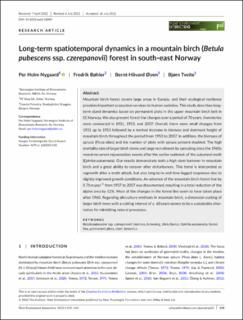| dc.contributor.author | Nygaard, Per Holm | |
| dc.contributor.author | Bøhler, Fredrik | |
| dc.contributor.author | Øyen, Bernt-Håvard | |
| dc.contributor.author | Tveite, Bjørn | |
| dc.date.accessioned | 2022-10-12T08:18:55Z | |
| dc.date.available | 2022-10-12T08:18:55Z | |
| dc.date.created | 2022-09-16T11:02:58Z | |
| dc.date.issued | 2022-08-06 | |
| dc.identifier.citation | Plant-Environment Interactions. 2022, 3 (4), 155-169. | en_US |
| dc.identifier.issn | 2575-6265 | |
| dc.identifier.uri | https://hdl.handle.net/11250/3025496 | |
| dc.description.abstract | Mountain birch forest covers large areas in Eurasia, and their ecological resilience provides important ecosystem services to human societies. This study describes long-term stand dynamics based on permanent plots in the upper mountain birch belt in SE Norway. We also present forest line changes over a period of 70 years. Inventories were conducted in 1931, 1953, and 2007. Overall, there were small changes from 1931 up to 1953 followed by a marked increase in biomass and dominant height of mountain birch throughout the period from 1953 to 2007. In addition, the biomass of spruce (Picea abies) and the number of plots with spruce present doubled. The high mortality rate of larger birch stems and large recruitment by sprouting since the 1960s reveal recurrent rejuvenation events after the earlier outbreak of the autumnal moth (Epirrita autumnata). Our results demonstrate both a high stem turnover in mountain birch and a great ability to recover after disturbances. This trend is interpreted as regrowth after a moth attack, but also long-term and time-lagged responses due to slightly improved growth conditions. An advance of the mountain birch forest line by 0.71 m year−1 from 1937 to 2007 was documented, resulting in a total reduction of the alpine area by 12%. Most of the changes in the forest line seem to have taken place after 1960. Regarding silviculture methods in mountain birch, a dimension cutting of larger birch trees with a cutting interval of c. 60 years seems to be a sustainable alternative for mimicking natural processes. | en_US |
| dc.language.iso | eng | en_US |
| dc.publisher | New Phytologist Foundation and John Wiley & Sons Ltd. | en_US |
| dc.rights | Navngivelse 4.0 Internasjonal | * |
| dc.rights.uri | http://creativecommons.org/licenses/by/4.0/deed.no | * |
| dc.title | Long-term spatiotemporal dynamics in a mountain birch (Betula pubescens ssp. czerepanovii) forest in south-east Norway | en_US |
| dc.title.alternative | Long-term spatiotemporal dynamics in a mountain birch (Betula pubescens ssp. czerepanovii) forest in south-east Norway | en_US |
| dc.type | Peer reviewed | en_US |
| dc.type | Journal article | en_US |
| dc.description.version | publishedVersion | en_US |
| dc.rights.holder | © 2022 The Authors | en_US |
| dc.source.pagenumber | 155-169 | en_US |
| dc.source.volume | 3 | en_US |
| dc.source.journal | Plant-Environment Interactions | en_US |
| dc.source.issue | 4 | en_US |
| dc.identifier.doi | 10.1002/pei3.10087 | |
| dc.identifier.cristin | 2052404 | |
| dc.relation.project | Norges forskningsråd: 165035 | en_US |
| cristin.ispublished | true | |
| cristin.fulltext | original | |
| cristin.qualitycode | 1 | |

